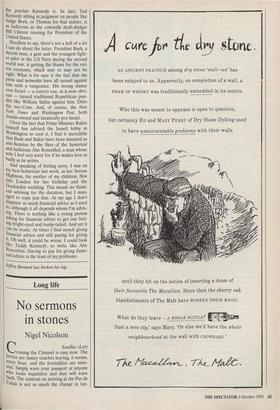Long life
No sermons in stones
Nigel Nicolson
CSouillac (Lot) rossing the Channel is easy now. The ferries are luxury coaches leaving, it seems, every hour, and the formalities are mini- mal. Simply wave your passport at anyone who looks inquisitive and they will wave back. The contrast on arriving at the Pas de Calais is not so much the change in Ian- guage and custom but the landscape. It seems an odd quirk of geography that one of the wealthiest and loveliest parts of Eng- land should confront across 20 miles of open water the poorest and least beautiful part of France. I am told that this is only the point of view of an impatient motorist. Wander a little and you will be rewarded by little valleys and pretty manor-houses. All I saw were sad stone villages and sad- der plains. I thought of the Panzers cross- ing this land in 1940.
I was heading for the Dordogne very impatiently indeed. British motorways explore our country: the French autoroutes bisect theirs. The Somme, the Seine, the Loire passed in a flash, and then I was within the comforting folds of the Auvergne. I am one of those people whose spirits rise with the hills and woods trailing from them like flung garlands. I slowed down, took to the by-roads and arrived punctually at the ancient stone manoir where I had been invited to spend the night. A curve of the Dordogne flashed like a scimitar far below it.
The kitchen was as capacious as a Nor- man chapel, and my hostess cooked duck for supper on the embers of a vast open fire. They told me that they had documen- tary evidence that the house dated from 1219, and a stone lintel worn to a wafer by the passage of a million footsteps was proof of it. We fell to talking about its likely his- tory through all the vicissitudes of France. They were insistent that so old a building must retain some memory of its past inhab- itants, their joys and tragedies, and that one can sense immediately on entering such a house whether it is happy or suf- fused with melancholy. I disputed them. I do not believe that stone, tile and timber can absorb emotion and reflect it centuries later. You can call a house serene, but you mean by it that its architecture and furnish- ings, or your hospitable reception, please you, or even the delicious smell of baking bread. If you think it gloomy, it is because you are affected by dank walls, hideous lampshades or a view of rain-soaked pines. My logical explanations did not carry con- viction. 'Imagine', said my host, `that an exact copy of this house was newly built in the middle of Miami or Calcutta. Would you receive the same impression of it as you did when you came in just now?'
I suppose not. But then my reaction would have been governed to some extent by what I expected to find. When later that day I entered the wonderful 12th-century monastery in Souillac, I had to admit that it was not simply the pale stone fashioned in graceful shapes that delighted me, but its numinous atmosphere. This was partly sug- gested by the usual furnishing of a church and its mediaeval carvings, like the famous bas-relief of Isaiah, and I was moved by the thought of the prayers that had been offered in it for centuries. But the stones were not telling me this: I was telling the stones.



















































 Previous page
Previous page